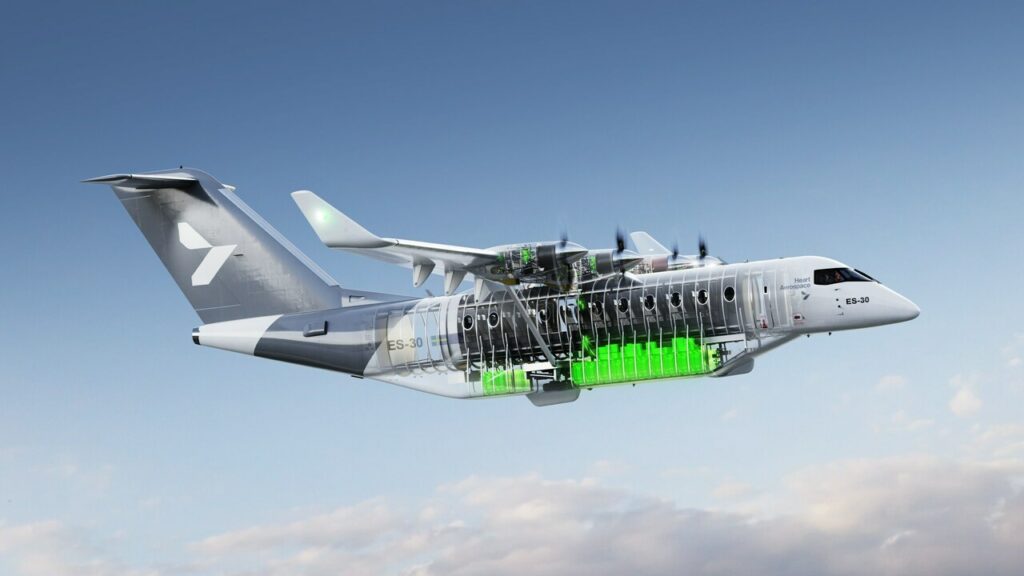Heart Aerospace’s Director of Government and Industry Affairs, Simon McNamara is poised to deliver a speech to the European parliament on December 5 to discuss the transition to electric flight in Europe.
The speech will delve into the transformative potential of electric flight in Europe and outline three key policy recommendations.
Amid the escalating climate crisis, the aviation industry finds itself at a crossroads, and Heart Aerospace seeks to pave the way for a sustainable, eco-friendly future.
Balancing Emissions and Connectivity
As the specter of climate change looms large, the aviation sector grapples with its environmental impact. According to Transport & Environment, aviation emissions surged from 1.5% in 1990 to 4.7% in 2019.
Despite this, air connectivity remains a linchpin in Europe, supporting 5 million jobs and contributing a substantial 2.1% to the continent’s GDP.
[monsterinsights_popular_posts_inline]

Heart Aerospace champions electric and hybrid-electric airplanes as the antidote to aviation’s carbon conundrum.
McNamara contends that embracing these technologies will not only decarbonize the sector but also revitalize it through reduced operational costs.
Regional Connectivity with the ES-30
Deploying regional electric and hybrid-electric aircraft, such as the innovative ES-30, could potentially double the number of airports with commercial air service in Europe.
This paradigm shift promises more accessible transport options, surging demand for regional aircraft, and a considerable jobs boost, aligning seamlessly with the EU’s commitment to inclusive connectivity.
Beyond regional benefits, the integration of electric aviation offers a symbiotic relationship with mainline airline operations.
Nimble regional operators can act as ‘feeders’ to primary hubs, enhancing overall value and growth. This symbiosis complements existing infrastructure, including large hub airports, highways, and high-speed rail networks.

Heart Aerospace is developing the ES-30, a regional electric airplane with a standard seating capacity of 30 passengers driven by electric motors with battery derived energy.
It will have a fully electric zero emissions range of 200 kilometers, an extended hybrid range of 400 kilometers with 30 passengers and flexibility to fly up to 800 kilometers with 25 passengers, all including typical airline reserves.
Heart Aerospace has a total of 250 firm orders for the ES-30, with options and purchase rights for an additional 120 planes. The company also has letters of intent for a further 91 airplanes.
Electric Aviation vs Sustainable Aviation Fuel (SAF)
While Sustainable Aviation Fuel (SAF) remains integral to net-zero targets, Heart Aerospace emphasizes that new technologies, like electric aviation, can contribute up to one-third of the decarbonization effort.
Acknowledging SAF’s scarcity, electric aviation emerges as a vital reliever, warranting proactive policymaker support.
Policy Recommendations
To ensure the success of electric aviation, Heart Aerospace will propose three key policy recommendations:
1. Equal Attention to New Technology
Policymakers must balance their focus between Sustainable Aviation Fuel and new technologies. A comprehensive approach, addressing both avenues, is crucial for effective aviation decarbonization.
2. Increased Funding for Innovation
Historically underfunded, aviation innovation needs a financial boost. Heart Aerospace advocates for increased funding, especially through initiatives like the EU Innovation Fund, to expedite the market entry of electric aviation projects.
3. Adapting European Policy
European policies must evolve to accommodate electric flight. From adapting Public Service Obligation Routes to revisiting Air Traffic Control charges, a holistic approach is needed.
Incentives, fiscal policies, and market access rules should all align with the EU Green Deal to actively support the acquisition of electric aircraft.

Click the banner to subscribe to our weekly newsleter.

Click the photo to join our WhatsApp channel so then you can stay up to date with everything going on in the aviation industry!









